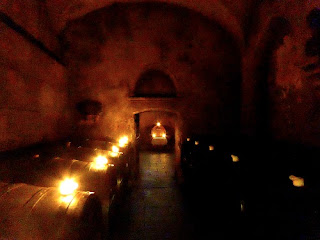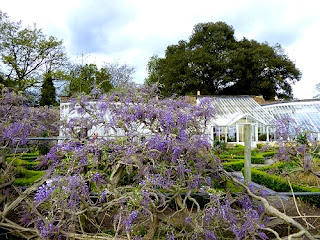First caught a real sense of strong sun on the late March Saturday afternoon and Sunday morning of my time in Lucerne attending four days of the Easter Festival.
Warmth day and night suffused Bremen at the time of the 150th anniversary performance of Brahms's German Requiem in the Cathedral (10 April, to be precise) while Spain (as a critic from El Pais told me) and the UK were shivering under grey skies.
Then, finally, there was a week of summer in London when plants and trees finally flourished. The 100-plus-year-old wisteria in Fulham Palace's walled garden was incipient
and then flowered in the more unstable conditions of the following week (sunshine and hail showers).
Spring in cities can be emancipating because you suddenly find everyone sitting outside cafes or lying/playing in the park. Lucerne was buzzing on Saturday lunchtime even as the ice melted away,
though there had been heavy snow two nights earlier as I returned from a stunning Schiff C minor programme and dived into a kebab shop to buy a falafel on the way back to the hotel (that entailed a wistful conversation with a melancholy Kurd who could not understand Erdoğan's 'crazy-man' behaviour; I commiserated most sincerely).
The Friday had been taken up with six hours of Haitink masterclasses, though the walk to 'work' was of course beguiling, with a crested grebe swimming beyond the reflection of a steamer's Swiss flag,
the lake later clearing to this
and mists over the mountains as I arrived at the KKL,
with the other side of the lake including the Hofkirche (St. Leodegar) looking very inviting during one of the breaks.
Saturday was entirely free until late afternoon, when I had to meet Bavarian Radio Symphony Orchestra cellist Lionel Cottet for more material on my Haitink piece in the BBC Music Magazine. That was a total pleasure. So was the stay in the Hofgarten, what the French would call a 'hotel de charme,' and I'm not on any sort of commission to sing its praises; let me just say that the large room with sets of windows on two sides, and views of the Dom and the mountains if you made an effort, was one of the nicest I've ever stayed in.
When J arrived after the first two of the Haitink sessions, we had an excellent fish lunch in the Hofgarten restaurant, and the staff were all delightful.
I've explored the Hofkirche before, but it was especially inviting to climb the steps in brilliant sunlight and take in the courtyard with the well and the noble Renaissance porch, partly concealed here.
The late-Renaissance interior is nearly all of a piece, dating from the years immediately following the fire that destroyed the Romanesque/Gothic church in 1633 (the rebuilt towers commemorate that style). An impressive high altar was partly concealed by the familiar pre-Easter/Lent purple
while a rectangular carving of the Virgin surrounded on her deathbed by the Apostles survived the fire and was shining in shafts of sunlight.
I hadn't explored the graveyard-cloister around the church before. It was good to see so many well tended with spring floral arrangements.
The sudden view of Mount Pilatus over the roof as I was looking at the crucifix on the west side took me by surprise.
Then it was down for lunch in town, just catching the end of a lively riverside market including stallholders from the Italian part of Switzerland, among them this vender of giant carciofi just packing up,
and a post-prandial walk around and along the 14th century towers and town walls. Here you get surely the best views in town - here, looking down on the old quarter with the KKL beyond.
and to the south-east with the towers of the Jesuitenkirche which would later that evening be one of the locations for the Lucerne Opera's stunning site-specific Schumann Faust-Szenen.
Birdsong was riotous and everything in flower or bud, including a horse chestnut in front of the Zytturm with its clock the first with the right to chime since the Middle Ages, 'maintained' by two giants.
Clear half-moon through branches
and snowdrop/primrose/crocus-rich fields above the descending walls and towers
before you head down from above the Hofkirche.
A final wander on the route behind the KKL towards Tribschen - I'd finally intended to go inside the Wagner house, but it didn't open until April -
with swan photobombing another attempted shot of a crested grebe (this one is actually more interesting).
The few hours spent indoors in sunny Bremen were well spent (see the entry on Paula Modersohn-Becker). But how wonderful to see the central Marktplatz thronging with people, either sitting outside or going about their business (as the Rathaus and the Bundesrath still fulfil their original purpose). En route from the hotel to the centre on my first morning, I came across a scene you might more readily associate with the Netherlands not so far to the west:
and then the glory of Bremen, the central square with the 'Wesel Renaissance' facade of the Rathaus central between the Church of Our Lady
and the Bishops' seat, the Dom where we heard the Brahms concert that evening.
60 per cent of the city was destroyed in World War Two bombing; the Rathaus and the 1404 giant statue of Roland, defender of civic rights, survived and have UNESCO world heritage status.
The original Gothic part of the Rathaus lies behind the late Renaissance facade of 1608-12; the lower market and assembly area is used for exhibitions (when I was there, fascinating photos of integrating immigrants into the community). An 'arcade of almost Italian lightness' (Phaidon) has benches for citizens to sit and enjoy the Marktplatz scene.
The Phaidon Cultural Guide describes the balcony-balustrade as 'excessively lavish', but the mythological and early-historic detail repays attention.
I was delighted to find the upper hall open during a drinks reception before the concert, and I'd like to have had a guide to hand to tell me more about it. I discovered it with one of the best companions on press gatherings, Peter from Hamburg
Bremen's Hanseatic splendours are represented by the ship-models and the paintings of whales and other sea-creatures on the walls.
This councillors' banqueting hall is again Renaissanced by the splendid Güldenkammer, once used for confidential sessions and with a musicians' gallery above.
Even more secret conference was held in a special room in the Ratskeller, approached by candlelight
and giving high-altar prominence to the oldest barrel of wine in Germany, dating from 1653.
The whole room is permeated with a port-y fragrance. Bremen was granted monopoly of the wine trade by the church in 1405. Bacchus reigned here thereafter, and 400 wines can still be sampled.
The barrels were transported up the Weser, less spectacular now but rather attractive, on the north side at least, down from the Marktplatz with the sailors' church of St Martin as backdrop (sadly it was locked when I tried to visit).
Near the Ratskeller entrance - we had an excellent lunch among the giant barrels - stands the 1951 statue of the would-be Bremen town musicians by Bauhaus sculptor Gerhard Marcks. This is their pyramidal moment where they create an almighty racket to frighten robbers out of a house in the woods.
As the charming Grimm version makes clear, the unwanted animals seem never to have got as far as the city, but settled down in their new home and presumably lived happily together for what remained of their lives.
Sunset as we entered the Cathedral for the German Requiem would be a good place to say auf wiedersehen to Bremen, but the next morning, which I've described elsewhere, was the proper coda. At the end of the excursion I discovered the city's best coffee, at the end of Böttcherstraße preserved thanks to the inventor of decaff. None of that, thanks; Büchlers hat die beste Bohnen, and I brought some back.
I also met colleague Nahoko in there - a nice parallel to our last coffee together in Tallinn last year, and similarly she was writing a postcard (she'd gone off to hear the carillon when I took this).
So homewards, and happy to settle here for a bit. Or I would be if the weather hadn't turned so unremittingly vile and cold again. Anyway, it turns out I was right to take parts of several afternoons off while the sun shone. And since my first visit to the Garden of Eden that is the restored walled garden and greenhouses of Fulham Palace was last July, I still have the chronicle of a year in the life to complete. The last magnolia flowers were still framing the Tudor gateway on a first inspection this year.
The only blight would seem to be the downsizing of the hives - for whatever reason, two beekeepers were dismantling some of the old ones
leaving one single stack, glimpsed here in the distance through apple blossom
which is - well, pretty is the only word; and the bees seem to like it.
There seems to be one old survivor, bent close to the ground
but the alleys are in good shape
and saplings have been planted in the grassy meadow. As for the wisteria, it's glorious both in the walled garden
and on the south wall of the house,
glimpsed here through the copper beech
which was only incipient in the sunny week
but flourishing the next (part of it on the left in this ensemble).
There's a gorgeous specimen in Old Brompton Cemetery, which makes this scene look positively autumnal.
Time for a fauna interlude - meeting up with goddog Ted and his owner Chris in Kensington Gardens during a brief cloudgather on a generally balmy Saturday.
In the distance here, were you to enlarge the picture sufficiently,
you'd see a flock of parakeets bobbing in the grass. I only caught one in focus.
They still delight with their exoticism, though they're shriekers and possibly getting a bit out of control along the Thames. On the other hand I can never see too much of the blackbird family resident in the back yard, and very insistent on clean water supplies daily in the birdbath, which I duly provide. Here's Mr B in the branches of the prunus after immersion.
My last excursion before the rains and bitter cold returned was to Chiswick Park further up the Thames.
Tulips grace a new planting in the formal beds in front of the greenhouses which boast a fine camellia collection
and up against the walls more wisteria flourishes,
rather gaudily complemented by more tulips.
My usual Rundweg via the ornamental bridge revealed the moorhens nesting prolifically in the middle of the lake/pond and a solitary swan completing a picture of wildness at the back of the temple.
And here's the most recent flourisher of all beyond the cascade, laburnum, which usually takes its place in the seasonal parade after wisteria's begun to flourish, but this year has come along simultaneously.
Let's hope normal spring progress will be resumed as soon as possible.








































































